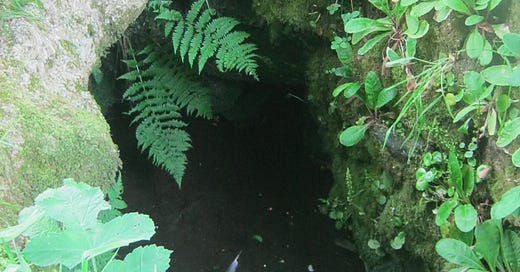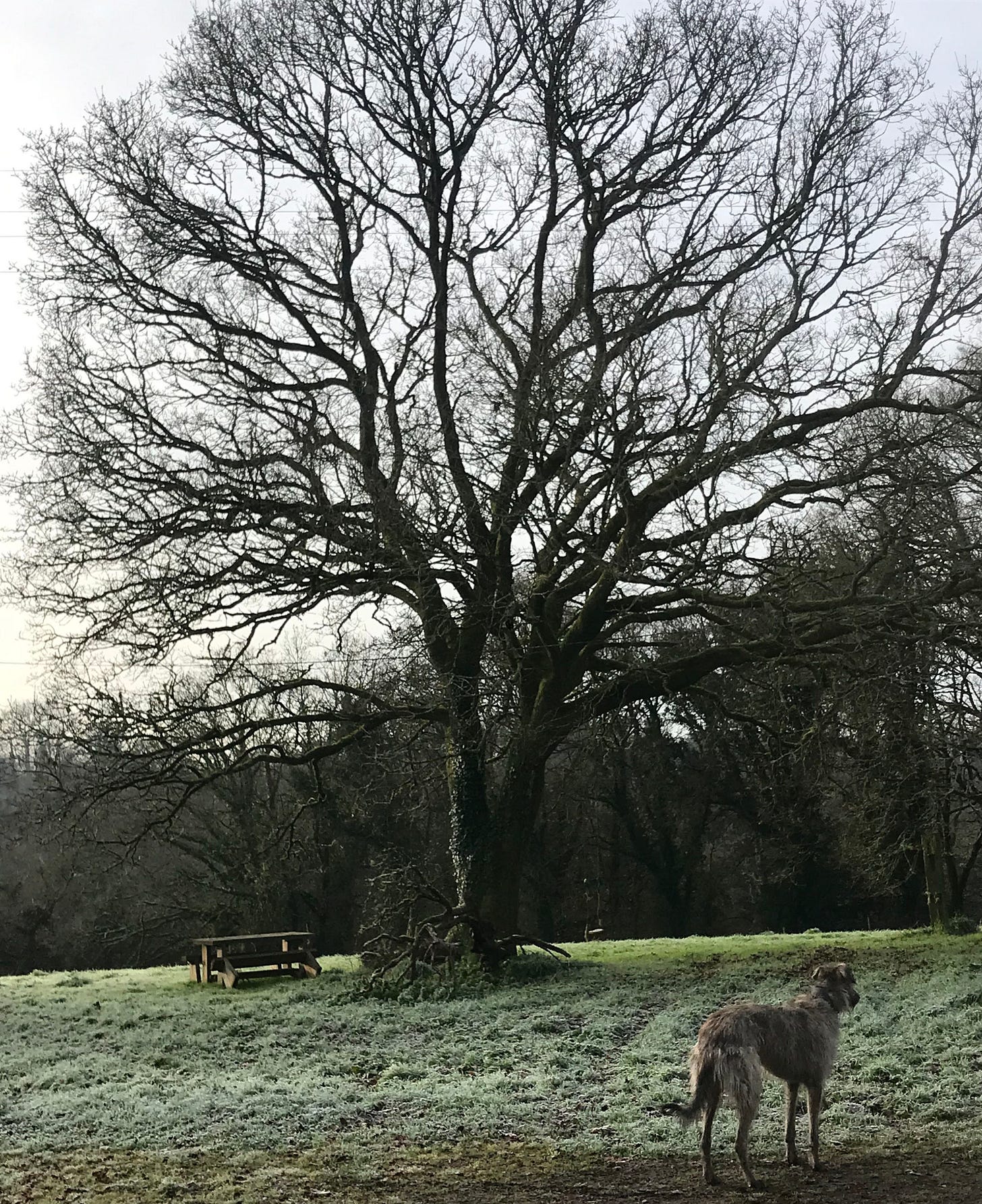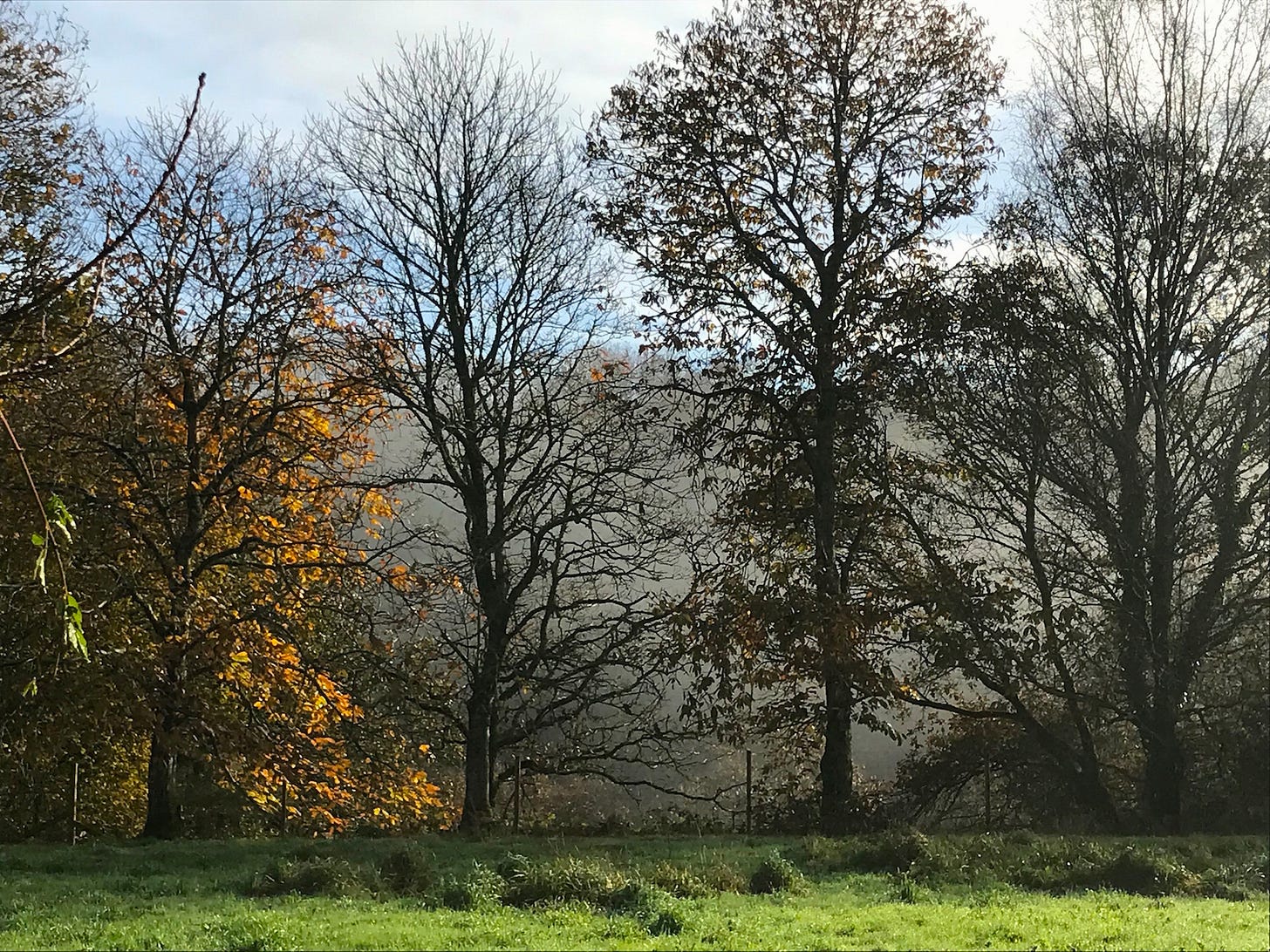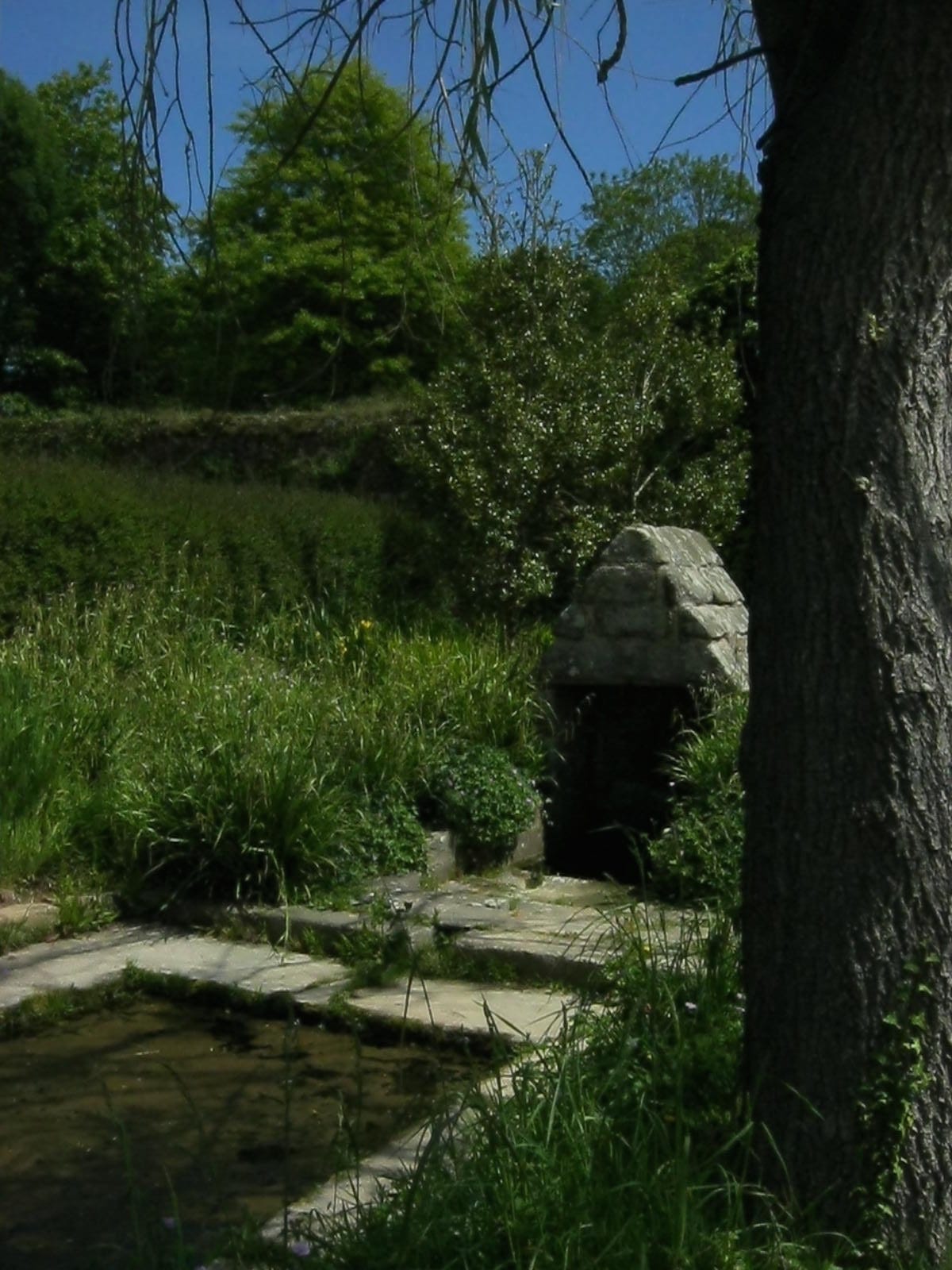‘… in Brittany a man [sic] could fall down a well and find himself in a summer land of apples. Or catch a fish-hook on the bell tower of a drowned church in another country. “Or walk through the gate of a barrow into Avallon,” she said.’
~ A S Byatt, Possession
Winter the architect
is a graphic designer rather than the Impressionist painter behind summer. And winter too is beautiful in its stark silvers and pewters, blacks and donkey-browns – or its frequent monochrome wet greys.
Now the fields have been ploughed and harrowed; the waves of furrows of last month converging on the horizon have been flattened, and rectangles complement the dramatic beauty of skeletal trees. Clouds of pigeon and fieldfare rise up from the remaining stubble fields as we pass; the raptors are more visible, buzzards and sparrowhawks hunting over the same fields; Sunday morning at dawn as I drove out of our gate towards the low full moon a pair of tawny owls, perhaps the ones we hear every night in the nearby oaks. The stories of the land seem more present in winter.
Ploughing still carries a sense of romance with it for many countrypeople, myself included. But ploughing, especially with a tractor, is not good for the land: it compacts the soil, makes it more vulnerable to erosion and topsoil loss, like most other commercial farming pursuits is terrible for biodiversity, breaks up the mycorrhizal network below the surface, kills off trillions and trillioans of our friends the earthworms.
There is too much of conventional farming in our immediate area, and yet the hinterland, the Monts d’Arée, a tiny version of my beloved Dartmoor, hosts many more eco-people, artists and craftspeople than one would guess, many of them trying, like us, to live a low-impact lifestyle. Like the hinterland, too, behind alternative capital Totnes, where we used to live, there’s a drift of eco-culture people moving westwards into Finistère, or Penn Ar Bed – the head of the land, the beginning or the end of the land, depending.
Finistère is also rich in its markets and craft fairs, its small farms that sell their own organic veg and bread on certain days of the week, and a great deal in the way of music.
So hello, I’m back
This post has taken any number of shapes, directions and wordcounts, the latter mostly ridiculous. This is why it’s overdue.
The last two weeks have been both difficult and overwhelmingly busy. Not tragic, not awful – I know how very fortunate I am – just challenging: bureaucratically, technologically, fiscally, mechanically.
It’s an annoying thing for a writer to be kept away from writing. So I am behind with the many things I wanted to share with you. Where to start?
The land
The land: we are still harvesting or processing some crops. The first Brussels sprouts have been picked; I’ve fermented some red cabbage, rainbow chard stems, beetroot and sweet potato in brine; there are more leeks, kale and cabbage plants than we can eat; we’re waiting for the first purple sprouting broccoli, a big favourite winter staple. The quinoa still needs threshing. A wonderful rash of kiwi fruits has spread fairly inaccessibly across the roof of the barn; not quite ripe, they need to be brought in and stored in a mouse-free zone before heavy frosts where, hopefully, they’ll ripen.
I’m delighted that we have chipped a heap of brushwood (as much again to go), and to have sourced some chickenwire to make containers for my raked-up leaves to rot down into humus. I love this feeding the land from the land thing, which is of course what happens in nature; we’re just speeding some of it up a little, prudently, to feed our crops too (currently mostly annual, though perennial are better for the earth: we’re working on that with the forest garden).
TM has done masses and masses of weeding of the veg plots in order to mulch with compost, woodchip, mowings and the like. I’m still trying to persuade him to come to the coast in early January after a storm or two for kelp; we spread 50-odd bags of it collected from the Devon shores each year before we emigrated.
Now he’s removed the tatty tarps and is cladding the back of one of the rickety barns with local Douglas fir planks, which will tidy it a lot.
Soon, we’ll be buying and planting more canopy trees and beginning the lower, second, storey of small trees or large shrubs in the forest garden. I’ll probably also be starting off comfrey, wild garlic, rosa rugosa, rosemary, mints and etc to start the makings of an understorey layer.
First, there is garlic to plant on the winter solstice, one of my solstice rituals, so this afternoon I’ve been clearing a patch for that.
Meantime…
I have been longing to pick up some writing I’ve left on one side: the second book of A Spell in the Forest, although the first book, the Forest book, ended up taking a different direction from that planned. In fact, I’ve now reverted to my original original idea and many of my initial writings and course materials, from which I felt I had to deviate a few years ago after someone ‘borrowed’ the core of this material.
Brittany, like the other places that so catch my heart – the Isle of Iona, Dartmoor, Exmoor and West Cornwall, for instance – is one of those ‘thin veil’ places, the ‘lands through the mist’ of the old tales. In certain spots it is easy to feel that a few more steps and you’ll emerge in the Otherworld. I have written about this so often in books, in essays and articles, also online, or spoken of it many courses over 34 years nearly, that it’s hard to find a fresh way of describing this. A S Byatt, at the top, describes this so brilliantly in so few words, so I’ll leave it with her there.
The visits and the saint
The week before last saw two visits from local people. One was the father of a young guy who lives up the lane. His father was born in that cottage, half a kilometre away from us, around 65 years ago, and knows the land we tend well. He came down with his son, partly for nostalgic reasons, and partly because he and I had been talking about the history of our place when I bumped into him in Huelgoat.
A couple of days later an elderly gentleman came to the gate with his two middle-aged offspring, who were clearly embarrassed that they would be bothering us; in fact, that they were there at all. I reassured them that on the contrary they would be most welcome to come in. It turned out, very quickly, that the elderly man had been born here 86 years ago, when the oak was a small sapling, and he remembered the chestnuts being planted, the various different small dwellings, and the tiny bocage fields bounded by banks and hedges.
To the first visitor, I said: ‘I have the sense that this parcel of land has been inhabited for a very long time; maybe even since the Iron Age’ (I believe I’ve mentioned before that the scarp we sit on is a mirror of various sites in Devon and Cornwall, each of which has the remains of Iron Age camps or forts). There are a number of features that suggest many centuries of human dwelling here, but it’s rather a deep in-the-blood sense than factual knowledge that I have in relation to this place. There are so many layers of human lives perceptible here. He didn’t look at all surprised, and said ‘I think that’s entirely possible’.
I didn’t say this to him, but it’s also the case that I hear voices here, and sometimes, especially in our first year, have smelled someone cooking breakfast at 4.30 or 5 in the morning – bearing in mind that we have no near neighbours – and nor do we get up at that time.
To both of them I mentioned that I also have a sense, and in fact know from ruins or hearsay, that there were once at least two wells on the land. Given that there was also a handful of dwellings, you’d expect that.
Both of them said that there were at least three and probably four, one of which had a name for having been a fontaine sacrée, or guérissante, a holy or healing well (‘healing’ being cognate etymologically with both wholeness and holy). Other people had mentioned this to us, including the previous inhabitants.
It had taken us a while, but we had tracked that latter well down to a spot in the woods, which fall very steeply to the stream. It has been very overgrown, and a large tree has blocked access; plus last winter, when we found it, it was only just a trickle (so much water has been siphoned off in the West for industry and industrial-scale agriculture that most of our aquifers are depleted now). There are however large stones around it, marking it out.
So I am inordinately pleased to have found it, the more so since I discovered whose well this was.
The immediate area around us here is, apparently, known as Languen, St Gwenn, or St Gwenn’s, after the saint whose well this was (‘Lan’, often found as a prefix, means saint’s place, or holy place, as does the prefix Loc which, Wendy Mewes tells us, is a later version). It’s not marked as such on maps, so only locals seems to know that. In Breton, guin, guen or gwenn, as in the Cornish guin, gwin/gwen or gwyn, can mean white, fair or holy. My Cornish surname, Angwin, comes from An Gwyn or An Gwen, my father always told us (‘an’ in this context meaning ‘the’).
Elsewhere, I’ve read a theory that ‘Gwen’, as in Gwenhwyfar or Guinevere as in the old tales, suggests an Otherworldly being, or someone from the race of the Fair Folk. The idea is that she came from the Otherworld to initiate the king, in this case Arthur. So my imagination in relation to this place, and the fact that I’m here, has gone into overdrive.
Those wells
Since I first ‘met’ Brittany in 1988 it’s the proliferation of holy wells and my/our relationship to these, both actually and symbolically, that has enthused me so. There is much to say about wells, their connection with the feminine principle, anima and/or soul, and the Wasteland of the Grail myths and T S Eliot’s famous poem, and I have said it in many places: on my old blog, in my first book Riding the Dragon – myth & the inner journey (Element 1993), on my websites, and a little in my most recent book Spell. There is more in the 100K-odd words I removed from that book, and which I am now considering redrafting to make this second book, possibly to be serialised on Substack next year. Since 1991 I have led workshops in this ‘Myth as Metaphor’ material; more to say on that, too, I hope, soon.
My friendship with holy wells began in my childhood, when my father took me to the wells of the far west of Cornwall, our homeland. As a solitary young teenager I used to bike to a quiet rather lost wood with its hermit chapel by a well. With my first boyfriend, whose parents were smallholders in the first post-John-Seymour wave on Exmoor, when I was 17 or so we’d drive to the many wells we’d plotted on a very large-scale map of Exmoor.
From then on, part of my personal spiritual practice well into adulthood and still on occasion now became cleaning out wells, mainly holy wells; for they’re usually sadly neglected in our time, water being one of the ‘resources’ we tend to squander unthinkingly, since after all it comes freely out of our taps, mostly; and sometimes we consider we have too much of it falling from the sky.
Wells have historically been revered. We know that in prehistoric times and into the Iron Age in Europe (and later too) the wells were sacred to the animist spirituality of the nature-based pagans. In the conversion of the pagan population to Christianity, most of the wells acquired a Christian saint instead (presumably declared ‘saint’ retrospectively; in those times that figure was not canonised, a later lengthy practice requiring papal assent. Many of these solitaries in Brittany would have been hermits, often missionaries from Wales, Devon or Cornwall.)
Many of those wells here still have a saintly figure in a niche above them. They’re often quite homely figures, and still receive offerings, like this one above the well near the spectacular prehistoric allée couverte, or passage grave, of Mougau Bihan in the Monts d’Arrée. In this way, and especially when there’s a lavoir, laundry-washing-place, attached as here, these spots blend the secular and the spiritual, the practical and the sacred, in a way that I find appealing. The sacred sits at the heart of even the most mundane activities, arguably.
Here in our district most of the outlying houses and all the hamlets have their own wells, but tragically boarded up; this seems so counter-intuitive – no, counter-practical given that parts of even wet Finistère in 2022/23 saw droughts.
So in Brittany, wells still are numerous; and some of them, the holy wells and/or the ones that have the lavoirs alongside them, have been restored or at least tended. Below is one near Morlaix, one of the tended ones.
I mentioned in an earlier post how one branch of the pilgrimage route of the Camino to Santiago de Compostella across France, one of the routes that probably mediaeval pilgrims from Britain picked up on arrival on the continent, winds into the local village; but the central fontaine, with its scallop shell, symbol of St Jacques, Sant Iago, or Saint James in English, the patron saint of this pilgrimage to his shrine at the famous cathedral, is dry and broken. (For more on a different and very Breton pilgrimage, see my friend Wendy Mewes’ new book The Unquiet Path on the Tro Breiz, a 1000k pilgrimage round the cathedrals of the seven founding saints of Brittany.)
So many wells untended. This is something we could change in our time; it would be a potent symbol, as well as maybe helping address water stress. On my occasional year-long The Wellkeepers course I urge people to adopt a local well – they exist still. (NB My websites need updating. This in turn depends on a new computer – in the early new year, I hope.) A New Year’s resolution?
~~~
I have more to say on wells; and with, I hope, some news, in the near future. For now, I guess these are plenty enough words.
As always, I so appreciate your reading. Thank you for your company and attention, your likes and your comments; and I love it too when you share these posts.
Wishing you all a joyful solstice and Yule at the forthcoming midwinter – or for some of you midsummer – turning.









Your reflection on wells as a connection between the practical and sacred beautifully illustrates how the past continues to inform our present - something that resonates deeply with my perspective on time and place. There's profound wisdom in your observation about the layers of human lives perceptible on your land; it's a gentle reminder that we are all temporary stewards rather than permanent owners. I find it touching that your elderly visitors brought their memories back to the land, validating what you've intuitively sensed about its history - it's a powerful reminder that if we quiet ourselves and truly listen, places will share their stories with us. Thank you for this thoughtful meditation on place, time, and our responsibility to both.
discovering the well sounds wonderful x